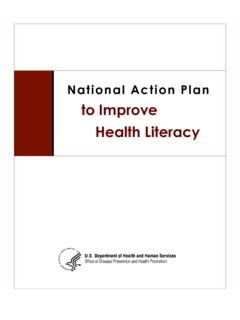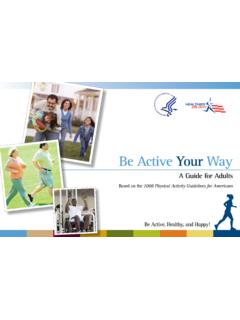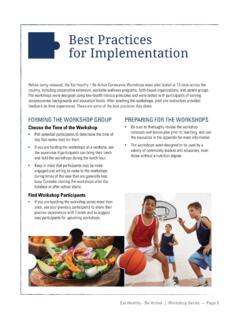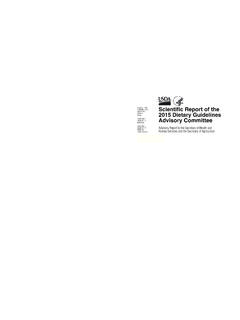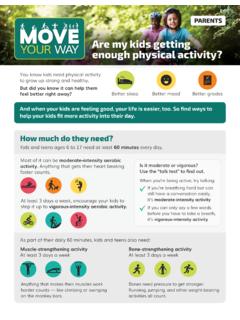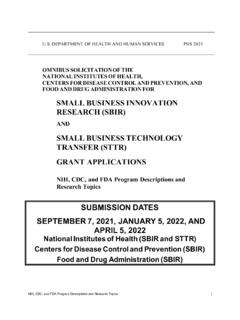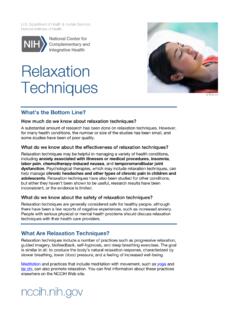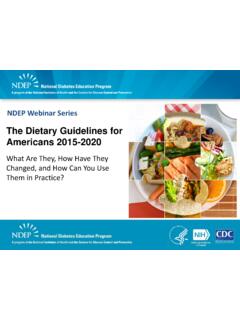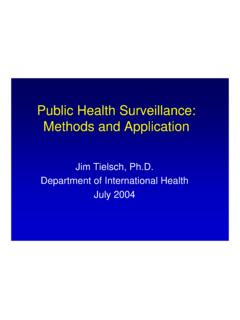Transcription of The National Youth Sports Strategy - Health
1 The National Youth Sports Strategy OFFICE OF THE ASSISTANT SECRETARY FOR HEALTHM essage from the Assistant Secretary for Health As the Assistant Secretary for Health , I oversee the Department of Health and Human Services (HHS) key public Health policy offices and programs, 11 Presidential or Secretarial advisory committees, 10 regional Health offices across the nation, the Office of the Surgeon General, and the Public Health Service Commissioned Corps. My office is committed to leading America to healthier lives. We are excited to publish our latest Strategy that promises to substantially improve the Health , longevity, and quality of life for Americans: the National Youth Sports Strategy . We know from our work developing the Physical Activity Guidelines for Americans, 2nd edition that Youth need at least 60 minutes of moderate-to-vigorous physical activity each day for good Health ; yet a majority of Youth are not moving enough.
2 Youth who are physically active are healthier, have less body fat, and exhibit improved cognition and mental performance. There can be additional benefits gained when playing Sports and the opportunity to develop physical literacy and important life skills. Despite these benefits, only 58 percent of Youth ages 6 to 17 participated in Sports in 2017, and the numbers are lower for girls, racial and ethnic minorities, Youth from households of low socioeconomic status, and Youth with a disability. In addition to these disparities, the cost of participation in Sports continues to be a major barrier for Youth and families across the country. Close to 60 percent of parents reported spending between $250 and $2,500 on Sports programming each year. Youth Sports is an estimated 15 billion-dollar industry, fueled by a pay-to-play model that often focuses on specialization rather than positive Youth development.
3 In February 2018, President Donald Trump issued Executive Order 13824, titled President s Council on Sports , Fitness & Nutrition, which directed the HHS Secretary, Alex M. Azar II, to develop a National Strategy on Youth Sports . Secretary Azar has entrusted the Office of the Assistant Secretary for Health (OASH) with the execution of this important work. The ultimate goal of the National Youth Sports Strategy is to increase Youth engagement in communities with below-average Sports participation and limited access to athletic facilities or recreational areas. The Office of Disease Prevention and Health Promotion, which recently developed and released the second edition of the Physical Activity Guidelines for Americans, led this effort on behalf of OASH. While developing the National Youth Sports Strategy , HHS worked closely with Ivanka Trump, Advisor to the President, and sought input from the scientific community, members of the public, Youth Sports organizations, and Federal offices.
4 As a result, the National Youth Sports Strategy outlines how all levels of society from Youth to policymakers can positively change the Youth Sports landscape in America. The National Youth Sports Strategy provides policymakers and key decision makers in Youth Sports programming with actionable strategies to increase awareness of the benefits of participation in Sports , increase participation in Sports , monitor and evaluate Youth Sports participation, and recruit and engage volunteers in Youth Sports programming. We view the National Youth Sports Strategy as an important first step to reorient the Youth Sports culture around a shared vision: that one day all Youth will have the opportunity, motivation, and access to play Sports , regardless of their race, ethnicity, sex, ability, or ZIP code. The National Youth Sports StrategyProgress to ensure access to safe, fun, inclusive, developmentally appropriate, and accessible Youth Sports opportunities requires a united effort.
5 We all have a role to play. I invite you to join me in helping the Youth of America be more physically active through Sports . Together, we can create an environment in which our most precious resource our Youth can foster a lifelong love of Sports and physical activity that will benefit them throughout their lives and lead to a healthier, more active nation. /S/ Brett P. Giroir, MD ADM, Public Health Service Assistant Secretary for Health Department of Health and Human Services 5 Table of Contents Acknowledgments ..7 Executive Summary ..11 Chapter 1. Introduction ..19 Chapter 2. Methodology ..23 Chapter 3. Federal Government Efforts in Physical Activity, Nutrition, and Youth Sports ..26 Federal Government Efforts Related to Physical Activity ..27 Federal Government Efforts Related to Nutrition ..28 Federal Government Efforts Related to Youth Sports ..29 BRIGHT SPOT: OSU LiFEsports: Reaching Vulnerable Youth Through Summer Sports .
6 32 Chapter 4. Tracking Youth Sports Participation and Access ..34 Current Trends in Youth Sports Participation ..35 Surveillance Efforts ..38 Chapter 5. Youth Sports Around the World ..45 Youth Sports in Selected Countries ..46 Sports for Diplomacy and Development ..47 Chapter 6. Benefits and Barriers Related to Youth Sports ..48 Benefits of Youth Sports Participation ..49 Inequities in Sports BRIGHT SPOT: Special Olympics Unified Sports : Promoting Social Inclusion Through Sports ..52 Barriers to Initial Participation and Continued Involvement ..54 Chapter 7. Opportunities to Increase Youth Sports Participation ..58 Level 1: Individual or Intrapersonal ..61 Opportunities and Action Items for the Individual or Intrapersonal Level ..62 Level 2: Interpersonal ..63 BRIGHT SPOT: Girls on the Run: Helping Girls Find Their Path ..66 Opportunities and Action Items for the Interpersonal Level.
7 68 Level 3: Organizational ..69 BRIGHT SPOT: Washington Nationals Youth Baseball Academy: Going to Bat for Inner-City Youth ..74 Opportunities and Action Items for the Organizational Level ..766 The National Youth Sports StrategyLevel 4: Community ..77 BRIGHT SPOT: The YMCA: Engaging Youth Across the Nation ..78 BRIGHT SPOT: Saturday Night Lights: Lighting the Way for Young Athletes ..81 Opportunities and Action Items for the Community Level ..83 Level 5: Public Policy ..83 Opportunities and Action Items for the Public Policy Chapter 8. Next Steps for HHS Action ..87 Opportunities and Action Items for the Department of Health and Human Services ..89 Appendix 1. Surveillance of Youth Sports Participation and Access ..91 Table 1. Federal Data Sources With Measures Related to Youth Sports Participation and Access ..92 Table 2. Non-Federal Data Sources With Measures Related to Youth Sports Participation.
8 95 References ..97 Suggested citation: Department of Health and Human Services. National Youth Sports Strategy . Washington, DC. Department of Health and Human Services; 2019. 7 Acknowledgments The Department of Health and Human Services would like to recognize the efforts of the Federal staff who oversaw the development of the National Youth Sports Strategy . Executive Committee Office of the Assistant Secretary for Health , Office of Disease Prevention and Health Promotion Don Wright, MD, MPH Richard D. Olson, MD, MPH Katrina L. Piercy, PhD, RD, ACSM-CEP; Lieutenant Commander, Public Health Service, Project Lead Alison Vaux-Bjerke, MPH Kate Olscamp, MPH, CHES Frances Bevington, MA Malorie Polster, MPH, CHES Lauren Darensbourg, MPH Joey King Centers for Disease Control and Prevention, National center for Chronic Disease Prevention and Health Promotion Janet E.
9 Fulton, PhD Sarah M. Lee, PhD National Institutes of Health , National Cancer institute Richard P. Troiano, PhD; Captain, Public Health Service Kyle Sprow, MPH, CSCS Office of the Assistant Secretary for Health , Office of Minority Health Felix Lorenzo, PhD, MPH, CPH (during assignment to support the President s Council on Sports , Fitness & Nutrition) Additionally, the Department acknowledges Kristina Harder, MPP, who served as the Acting Executive Director of the President s Council on Sports , Fitness & Nutrition starting in July 2019; David Mansdoerfer, MPP, from the Office of the Assistant Secretary of Health ; and Holli M. Richmond, Shannon Feaster, MS, and Ebony Andrews, MPH, who previously worked to support the President s Council on Sports , Fitness & Nutrition. 8 The National Youth Sports StrategyFederal Work Groups Staff volunteered to serve on work groups to support drafting of the National Youth Sports Strategy from February through May 2019.
10 Work Group 1: Benefits and Barriers of Youth Sports Participation Lauren Darensbourg, MPH, Office of Disease Prevention and Health Promotion, Work Group Lead Namanjeet Ahluwalia, PhD, Centers for Disease Control and Prevention, National center for Health Statistics Andrew Bremer, MD, PhD, MAS, National Institutes of Health , Eunice Kennedy Shriver National institute of Child Health and Human Development Rafael D. Campos, MPS, Office of the Surgeon General Michelle Dennison-Farris, PhD, RD/LD, BC-ADM, CDE, Office of the Assistant Secretary for Health Region 6 Erica Ferguson, MPH, Office of the Assistant Secretary for Health Region 4 Joey King, Office of Disease Prevention and Health Promotion Karen Lee, MD, MPH, National Institutes of Health , Eunice Kennedy Shriver National institute of Child Health and Human Development Richard D. Olson, MD, MPH, Office of Disease Prevention and Health Promotion Adrianne Phenix, MS, CHES, Office on Women s Health Lauren Ramos, MPH, Health Resources & Services Administration, Maternal and Child Health Bureau Kyle Sprow, MPH, CSCS, National Institutes of Health , National Cancer institute Richard Troiano, PhD, National Institutes of Health , National Cancer institute Work Group 2: Public and Private Strategies Kate Olscamp, MPH, CHES, Office of Disease Prevention and Health Promotion, Work Group Lead Kaitlin Bagley, MPH, CPH, Health Resources & Services Administration, Maternal and Child Health Bureau Lauren Darensbourg, MPH, Office of Disease Prevention and Health Promotion Laurie Konsella, MPA, Office of the Assistant Secretary for Health Region 8 Katrina L.
